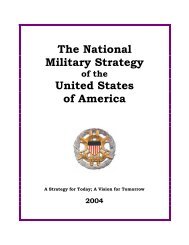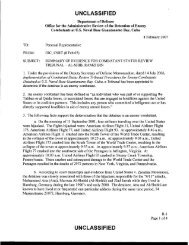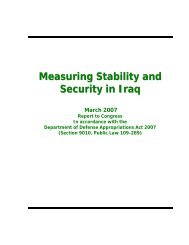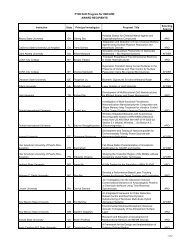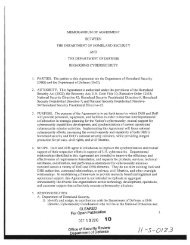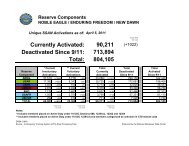Report - United States Department of Defense
Report - United States Department of Defense
Report - United States Department of Defense
You also want an ePaper? Increase the reach of your titles
YUMPU automatically turns print PDFs into web optimized ePapers that Google loves.
UNCLASSIFIED<br />
Counter-corruption within MoD remains a key concern, and counter-corruption efforts remain<br />
nascent. Poor manning <strong>of</strong> MoD advisor counter-corruption efforts, limited authorities and focus<br />
on the effort from ISAF, and numerous frictions within MoD preclude scoping the problem<br />
accurately at this time. Few cases are reported and tracked at the MoD and GS level, primarily<br />
due to the lack <strong>of</strong> anonymity in reporting, fear <strong>of</strong> reprisal against “whistle blowers,” widespread<br />
belief that the investigative arms <strong>of</strong> MoD are themselves heavily corrupted, and unnecessarily<br />
restrictive language in investigative process regulations preventing or greatly slowing any<br />
investigation. MoD advisors lack the personnel authorities to oversee and assist the MoD<br />
investigative process properly. Minister <strong>of</strong> <strong>Defense</strong> Mohammadi appears to want to take<br />
decisive action to understand the scope and methods <strong>of</strong> corruption in MoD, and apply the<br />
necessary countermeasures.<br />
Assessment <strong>of</strong> the Ministry <strong>of</strong> Interior<br />
Relative to the last reporting period, the MoI has progressed significantly. Although still short <strong>of</strong><br />
its fielded force generation goal <strong>of</strong> 157,000 personnel, efforts to pr<strong>of</strong>essionalize the force have<br />
led to improvements in capability milestones (CM). The most recent monthly ISAF Ministerial<br />
Development Board (MDB) voted in December 2012 to assess the overall MoI development<br />
status at CM-2B, meaning that ministries are capable <strong>of</strong> accomplishing their mission but require<br />
some coalition assistance.<br />
Noteworthy trends include a doubling <strong>of</strong> the ministries at CM-1B or greater from two to four<br />
(Public Affairs, Legal Advisor, Policy Development, and ANCOP (all pending NTM-A/CSTC-A<br />
Command approval)), the reduction <strong>of</strong> units at CM-4 from two to zero, and the addition <strong>of</strong> a new<br />
agency to the MDB, the Afghan National Fire and Disaster Response Emergency Services<br />
Agency. Of the 32 MoI pillars, almost three-fourths (72 percent) are at CM-2B or better. There<br />
are 19 units at the CM-2 level (CM2A=9; CM2B=10). Of these, all but two (Inspector General<br />
and Afghan Local Police (ALP)) are projected to be at CM-1B or higher in 2013, with the other<br />
two trailing in 2014.<br />
Viewed from either a security or support perspective, the strength <strong>of</strong> MoI lies in its major<br />
security pillars. Shortfalls, however, exist in the support pillars buttressing these security<br />
elements. The five primary support areas at the CM-3 level are Gender Affairs; Logistics;<br />
Facilities; Information Technology; and Counter-IED. Trends in these areas have not changed<br />
significantly from the last reporting period. Associated challenges include reluctance <strong>of</strong> MoI<br />
provincial leadership to place female hiring as top priority; inadequate numbers <strong>of</strong> trained<br />
logisticians; inability <strong>of</strong> the Facilities <strong>Department</strong> to fill more tashkil positions; lack <strong>of</strong><br />
Information Technology personnel to support program expansion <strong>of</strong> electronic solutions; and<br />
Counter-IED’s lack <strong>of</strong> trained teams.<br />
Since the appointment <strong>of</strong> Minister Patang in September 2012, the MoI has made significant steps<br />
to empower ministerial leadership and pr<strong>of</strong>essionalize MoI’s internal security force. Patang’s<br />
efforts resulted in measurable progress, including merit-based promotions, overhauling the ANP<br />
tashkil and structure, standing up community policing units, improving police training and the<br />
prison system, making timely preparations for the 2014 elections, and properly equipping the<br />
ABP.<br />
56



